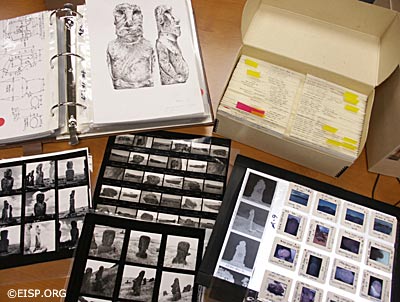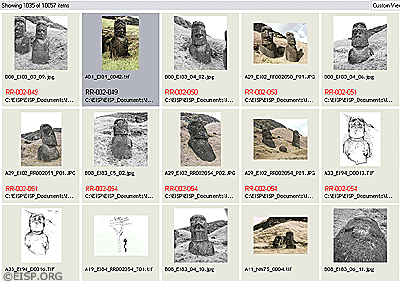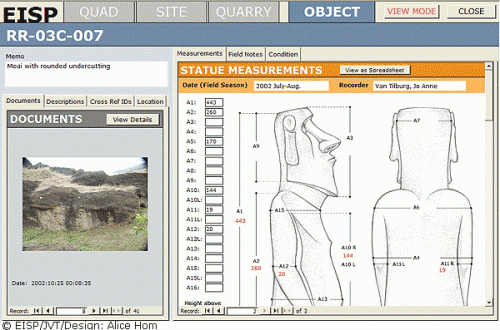The Easter Island Statue Project Archive and Database

Variety of film and paper media archived and digitized for the EISP database. ©2005 EISP/JVT/ Photo: A. Hom
EISP Database Defined
The Easter Island Statue Project (EISP) database is a comprehensive, interactive, searchable computer-based file of all moai data collected by Jo Anne Van Tilburg and her various field teams during archaeological fieldwork on Rapa Nui and, as well, during her extensive museum studies since 1982.
EISP Database Purpose
The purpose of EISP is to amass large quantities of objective data in standardized ways, creating a body of information which, when analyzed, enables the recognition of patterns illustrating shared cultural norms that will allow for outlining and defining the prehistoric social system.
Categories of Descriptive Data
The EISP database contains the following broad categories of data types: quadrant descriptions, quadrant images, site and statue images, site type definitions, statue type definitions, statue measurements, site descriptions, narrative field notes, statue condition reports, cross-reference identifiers, political divisions, historical and ethnographic observations, and survey and excavation histories.
Raw Data Storage
The materials that make up the EISP database are all contained in the EISP. Everything is stored in safe conditions, with duplicate backup records in three different locations. The database itself is stored on three computers, one of which is with Van Tilburg and the other with C. Arévalo P.

Screen capture of thumbnails from the EISP digital image catalog, currently containing over 30,000 items.
Image Database
The EISP image database currently contains nearly 12,000 images with a probable final count of 15,000 or more.
Statue Inventory Database
The following materials, all generated by original EISP fieldwork, are contained in the Inventory database:
- black and white photographs
- black and white negatives
- 35 mm color slides
- large format color slides
- pencil rough drawings, notes, maps and plans
- pen and ink on vellum finished drawings, maps and plans
- statue measurements
- statue conservation observations
- project correspondence
Metric Database
The EISP metric database currently contains 1 to 55 measurements for every statue documented in several discrete categories and recorded on generic statue form diagrams.

A view of the original digital EISP database interface designed for data entry of statue measurements and field notes, to organize digitized historic information from multiple sources into a single statue record. This database runs on common software and is easily taken into the field for reference.
Mapping Database
The baseline of the mapping database is the quadrant maps published by the University of Chile (Cristino et al. 1981; the maps were produced by various individuals involved in various aspects of the island-wide survey from 1968 to 1981, and define individual quadrants numbered 1-14, 18 and 28). These maps contain numbered references to individual sites but exclude all site definitions.
Statues on various site types within quadrants 1-14, 18 and 28 are designated by a trinomial stating quadrant number, site number and statue number. These statues were recorded by Van Tilburg between the years 1981-1986 and fully reported in her Ph.D. dissertation (1986). Additional sites similarly designated were recorded from 1987 to 1989.
Statues recorded outside of these published quadrants have been recorded from 1990 to the present. The goal on these sites is to continue to employ the established trinomial system. This requires the cooperation of the University of Chile team responsible for the initial map publication or of other individuals or agencies in a similar role. Alternatively, EISP will assign site and statue numbers within the quadrant system. The GPS map of Rano Raraku interior generated by EISP will be the project’s organizing system for reporting all statue site and style data.
Statue Condition Reports
Statue condition reports were consistently completed on all statues in the database prior to 1986. These condition reports are all subjective observations of statue situation, condition, and conservation. In 2004, our condition reporting system was reviewed by members of the Getty Conservation Center staff, and some terms or categories of data were revised. These new-format statue condition reports were then completed by team members for every statue documented in the interior slopes and quarries, and for all of those standing or fallen on the exterior, during the 2004 field season.
Supporting Data
The EISP supporting database currently contains hundreds of non-EISP images and measurements of Easter Island statues, rock art and other art or ritual objects provided by nearly 100 individuals and nearly all major curatorial institutions in North America, South America, Europe, Australia, New Zealand and Indonesia. Included are image collections from the Mana Expedition to Easter Island, 1914-15; the private Alfred Métraux photographic collection and copies of museum collection images held by the Henri Lavachery estate. In addition, the database contains extensive original documentation of monolithic statues in museum collections, and other important objects, personally collected by Van Tilburg (1986-present) and Arévalo P. (2000-present).
Database Management Strategy
The EISP database manager works both in the lab and in the field, and has been in the field for many seasons. She has designed and constructed the database with direct or indirect professional input from a variety of sources, including the UCLA Rock Art Archive Computer Analyst, Getty Conservation Center staff, and the UCLA/Getty Conservation Center Masters Degree in Conservation Program. The programs employed include Portfolio 7 for image database management, Microsoft Access and Excel for metric and other data management, and Adobe Photoshop and Illustrator for image editing. The Statdat metric database is managed by the SAS statistical package. Microstation GIS and GPS tools are used for management of mapping data.
Official Reports and Data Sharing
An EISP report summarizing every field season has been written and filed with the Universidad de Chile (to 1990) and the UCLA Rock Art Archive (to 1986). Copies of all original raw data collected between 1981 and 1986, including a full set of black and white images of all standing statues in Rano Raraku, were provided directly to the Universidad de Chile. Since the inception of the Rano Raraku interior quarry mapping project, in-person and written reports have been provided to the Consejo de Monumentos, CONF and the Municipalidad of Hanga Roa.
Publications
Jo Anne Van Tilburg has an extensive publication record, and preliminary results of EISP have been published on an on-going basis since the project’s inception. These publications vary widely as to type, but the vast majority of her articles appear in refereed professional journals, encyclopedia entries (in English, Spanish and Italian) and in publications of leading museums, universities or professional societies.
Public Education, Professional Organizations and Outreach
Jo Anne Van Tilburg has participated in regular exchanges of information, chaired conferences and symposia held by the Society of American Archaeology, the Archaeological Association of America, the Pacific Arts Association and other professional organizations to report EISP research. She has published widely for young people through the Archaeological Association of America, and has participated in dozens of television documentaries reporting aspects of her research and presented by reputable and leading scientific programs or agencies. These programs have all been translated into Spanish and are regularly seen throughout the world. In this way, the information gathered by EISP reaches a wide audience.
EISP Website
The EISP website reports aspects of the on-going fieldwork on the UCLA server, and is linked to major research institutions throughout the world at www.eisp.org.
EISP-Rapa Nui Collaboration
In addition to regular accountability through island-based governmental agencies, EISP has always collaborated closely with the Rapanui community, and has always acknowledged that cooperation by naming the involved individuals in all publications. We have employed Rapanui field workers on a consistent basis, and trained each of them in the use and management of our database programs. Most significantly, Rapanui artist Arévalo P., who began as a field worker with the project in 1989, is now co-investigator, colleague and collaborator in all aspects of the project.
EISP Professional Collaboration
We have long-standing and regular accountability to island-based governmental agencies named in this report, and cooperative relationships, as well, with the University of Chile, Museo Antopológico Padre Sebastián Englert, and Museo Nacional de Historia Natural, Santiago. We have always been open to all other interested Chilean public or governmental agencies. We have long-standing research ties with major institutions, including the Smithsonian Institution and the British Museum, as well as formal and informal exchanges with all legitimate researchers working to further the understanding of Rapanui prehistory through archaeological or ethnographic research.
EISP Data Analysis
EISP research utilizes statistical and other analyses programs to investigate the following hypotheses:
a. Morphological and stylistic statue design attributes are capable of description, analysis and classification;
b. Morphological style of monolithic sculpture will relate to ceremonial architecture (ahu) construction type;
c. Statue style sequence will relate to ceremonial architecture chronology;
d. The greatest number of statues will be located in relation to the largest and most important lineage centers, and specific morphological and stylistic attributes will be associated with the statues on these centers;<
e. Statue type with relate to architectural phase, establishing a site-specific chronological sequence;
f. Chronological sequences will have validity for all sites within type categories;
g. The typical chiefdom may be defined in terms of statue style, territory, population and resource use.
Research Value of the Database
Conservation Value of the Database
All restoration, conservation or reconstruction of monolithic sculpture on all sites can benefit from the consultation or use of EISP statue condition reports. All management strategies for Rano Raraku are dependent upon this database. Successful cultural management of the entire archaeological patrimony of Rapa Nui can be enhanced through input provided by EISP.
Archiving the EISP Database
Full and complete CD-ROM copies of the EISP database will be provided to the appropriate Chilean and Rapa Nui public agencies for stewardship, updating and on-going use after completion of Van Tilburg and Arévalo P.’s research and the full publication of EISP results, anticipated to be in two to five year’s time. In the meantime, on-going reports of all field work accomplished will be provided via hard copy and on CD-ROM as appropriate. As of spring 2009, a web-based database application is in development to foster better collaborative data-sharing methodologies and controlled dissemination of data to researchers and Chilean authorities.
External Links
UCLA Rock Art Archive
Getty Conservation Institute
 English
English  Español
Español